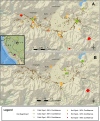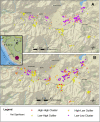Geospatial analysis of the associations between environmental contamination with livestock feces and children with chronic fascioliasis in the Anta province of Cusco, Peru
- PMID: 35709246
- PMCID: PMC9242436
- DOI: 10.1371/journal.pntd.0010499
Geospatial analysis of the associations between environmental contamination with livestock feces and children with chronic fascioliasis in the Anta province of Cusco, Peru
Abstract
Fasciola hepatica is a neglected parasitic infection with significant human health and livestock industry impact. The Andean Altiplano harbors an estimated 50% of the Fasciola's world infection burden. There is scarce data regarding the spatial associations between different Fasciola hosts. In this project, we aimed to determine the geospatial relationships between Fasciola eggs passed in feces of different livestock species and the risk of infection among each household as a unit. We used data from a cross-sectional study evaluating children and livestock feces for Fasciola infection around households in three districts of Anta province, in the Cusco region of Peru. Each sample was geographically tagged and evaluated for fascioliasis using microscopy methods. A total of 2070 households were included, the median age was 9.1 years (6.7-11.8), 49.5% were female, and 7.2% of the households had at least one infected child. A total of 2420 livestock feces samples were evaluated. The infection rate in livestock samples was 30.9%. The highest infection rate was found in sheep with 40.8%, followed by cattle (33.8%), and swine (26.4%). The median distance between a household with an infected child to a positive animal sample was 44.6 meters (IQR 14.7-112.8) and the distance between a household with no infected children to a positive animal sample was 62.2 meters (IQR 18.3-158.6) (p = 0.025). The multivariable logistic regression adjusted by presence of poor sanitation, unsafe water consumption, altitude, and presence of multiple infected children per household demonstrated an association between household infection and any cattle feces at a 50 meters radius (Uninfected: OR 1.42 (95%CI 1.07-1.89), p = 0.017. Infected: OR 1.89 (95%CI 1.31-2.73), p = 0.001), positive cattle feces at a 100 meters radius (OR 1.35 (95% CI 1.08-1.69), p = 0.008), and negative cattle feces at a 200 meters radius (OR 1.08 (95% CI 1.01-1.15), p = 0.022). We identified potential hot and cold spots for fascioliasis in the Anta province. An association between environmental contamination with feces from different livestock species and infected children in rural households was found in our study. Local health authorities may apply this strategy to estimate the risk of infection in human populations and apply targeted interventions.
Conflict of interest statement
The authors have declared that no competing interests exist.
Figures



Similar articles
-
Fasciola hepatica Infection Risk for Adult Household Members Living with Children with Fascioliasis in Cusco, Peru.Am J Trop Med Hyg. 2021 May 3;104(6):2069-2073. doi: 10.4269/ajtmh.21-0131. Am J Trop Med Hyg. 2021. PMID: 33939646 Free PMC article.
-
Comparison of Liver Condemnation and Bile Microscopy As Tools to Estimate Fasciola hepatica Prevalence and Burden in the Anta Province of Cusco in Peru.Vector Borne Zoonotic Dis. 2021 Sep;21(9):707-712. doi: 10.1089/vbz.2020.2753. Epub 2021 Jun 14. Vector Borne Zoonotic Dis. 2021. PMID: 34129405 Free PMC article.
-
Fluke egg characteristics for the diagnosis of human and animal fascioliasis by Fasciola hepatica and F. gigantica.Acta Trop. 2009 Aug;111(2):150-9. doi: 10.1016/j.actatropica.2009.04.005. Epub 2009 Apr 16. Acta Trop. 2009. PMID: 19375410
-
Human case of Fasciola gigantica-like infection, review of human fascioliasis reports in Nepal, and epidemiological analysis within the South Central Asia.Acta Parasitol. 2018 Sep 25;63(3):435-443. doi: 10.1515/ap-2018-0053. Acta Parasitol. 2018. PMID: 29975653 Review.
-
Global prevalence of liver disease in human and domestic animals caused by Fasciola: A systematic review and meta-analysis.J Glob Health. 2024 Sep 19;14:04223. doi: 10.7189/jogh.14.04223. J Glob Health. 2024. PMID: 39297588 Free PMC article.
Cited by
-
Spatial analysis and risk mapping of Fasciola hepatica infection in dairy cattle at the Peruvian central highlands.Parasite Epidemiol Control. 2023 Nov 23;23:e00329. doi: 10.1016/j.parepi.2023.e00329. eCollection 2023 Nov. Parasite Epidemiol Control. 2023. PMID: 38125009 Free PMC article.
References
-
- Fuentes MV, Valero MA, Bargues MD, Esteban JG, Angles R, Mas-Coma S. Analysis of climatic data and forecast indices for human fascioliasis at very high altitude. Ann Trop Med Parasitol. 1999;93(8):835–50. - PubMed
Publication types
MeSH terms
Grants and funding
LinkOut - more resources
Full Text Sources

